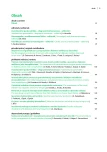Empagliflozin – the new representative of SGLT2 transporter inhibitors for the treatment of patients with diabetes 2 type
Authors:
Martin Prázný 1; Jiří Slíva 2
Authors‘ workplace:
III. interní klinika 1. LF UK a VFN, Praha, přednosta prof. MUDr. Štěpán Svačina, CSc.
1; Ústavy farmakologie 2. a 3. LF UK, Praha, prof. MUDr. Jan Bultas, CSc.
2
Published in:
Vnitř Lék 2015; 61(2): 175-178
Category:
Actualities
Overview
Empagliflozin is a new medicine used to reduce hyperglycemia in patients with type 2 diabetes. It belongs to the most advanced class of antidiabetic drugs, known as gliflozins, which prevent reabsorption of glucose through inhibiting SGLT2 sodium-glucose cotransporter. Thereby they cause therapeutic glycosuria, thanks to which a loss of approximately 70 g of glucose per day occurs. This not only effects the decrease in glycemia, but also the loss of body mass, since this excreted glucose cannot be used as an energetic substrate. The studies within phase 3 have proven the therapeutic efficacy of empagliflozin in monotherapy, in combination with the other oral antidiabec drugs and insulin. Another favourable effect of empagliflozin is a slight decrease in blood pressure. In May 2014, empagliflozin was approved for the treatment of patients with type 2 diabetes within the European Union 2014, since October 2014 it has been available in the Czech Republic and since 1 February 2015 empagliflozin (under the trade name Jardiance®) has been partially covered by the health insurance for the treatment of patients with type 2 diabetes either in combination with metformin or in combination with insulin (with or without metformin).
Key words:
empagliflozin – glycosuria – hyperglycemia – T2DM – type 2 diabetes mellitus
Sources
1. Ehrenkranz JR, Lewis NG, Kahn CR et al. Phlorizin: a review. Diabetes Metab Res Rev 2005; 21 : 31–38. Dostupné z DOI: <http:// DOI: 10.1002/dmrr.532>.
2. Scheen AJ. Pharmacokinetic and pharmacodynamic profile of empagliflozin, a sodium glucose co-transporter 2 inhibitor. Clin Pharmacokinet 2014; 53(3): 213–225.
3. Ferrannini E, Muscelli E, Frascerra S et al. Metabolic response to sodium-glucose cotransporter 2 inhibition in type 2 diabetic patients. J Clin Invest 2014; 124(2): 499–508.
4. Arnouts P, Bolignano D, Nistor I et al. Glucose-lowering drugs in patients with chronic kidney disease: a narrative review on pharmacokinetic properties. Nephrol Dial Transplant 2014; 29(7):1284–1300.
5. Macha S, Rose P, Mattheus M et al. Pharmacokinetics, safety and tolerability of empagliflozin, a sodium glucose cotransporter 2 inhibitor, in patients with hepatic impairment. Diabetes Obes.Metab 2014; 16(2): 118–123.
6. Roden M, Weng J, Eilbracht J et al. Empagliflozin monotherapy with sitagliptin as an active comparator in patients with type 2 diabetes: a randomised, double-blind, placebo-controlled, phase 3 trial. Lancet Diabetes Endocrinol 2013; 1(3): 208–219.
7. Häring HU, Merker L, Seewaldt-Becker E et al. Empagliflozin as add-on to metformin in patients with type 2 diabetes: a 24-week, randomized, double-blind, placebo-controlled trial. Diabetes Care 2014; 37(6):1650–1659.
8. Häring HU, Merker L, Seewaldt-Becker E et al. Empagliflozin as add-on to metformin plus sulfonylurea in patients with type 2 diabetes: a 24-week, randomized, double-blind, placebo-controlled trial. Diabetes Care 2013; 36(11): 3396–3404.
9. Kovacs CS, Seshiah V, Swallow R et al. Empagliflozin improves glycaemic and weight control as add-on therapy to pioglitazone or pioglitazone plus metformin in patients with type 2 diabetes: a 24-week, randomized, placebo-controlled trial. Diabetes Obes Metab, 2014; 16(2): 147–158.
10. Merker L, Häring HU et al. Empagliflozin (EMPA) for ≥ 76 weeks as add-on to metformin in patients with type 2 diabetes (T2DM). Diabetes 2014; 63(Suppl 1): A278. 1074-P. Dostupné z DOI: <http://doi: 10.2337/db14–833–1316>.
11. Häring HU, Merker L et al. Empagliflozin (EMPA) for ≥76 Weeks as Add-on to Metformin Plus Sulfonylurea (SU) in Patients with Type 2 Diabetes (T2DM). Diabetes 2014; 63(Suppl 1): A280. 1077-P. Dostupné z DOI: <http://doi: 10.2337/db14–833–1316>.
12. Kovacs CS, Veeraswamy S et al. Empagliflozin (EMPA) for ≥76 Weeks as Add-on to Pioglitazone With or Without Metformin in Patients with Type 2 Diabetes (T2DM). Diabetes 2014; 63(Suppl 1): A273. 1055-P. Dostupné z DOI: <http://doi: 10.2337/db14–833–1316>.
13. Rosenstock J et al. Empagliflozin as add-on to basal insulin for 78 weeks improves glycaemic control with weight loss in insulin-treated type 2 diabetes (T2DM). Poster: 931, 49th Annual Meeting of the European Association for the Study of Diabetes, 23–27 September 2013, Barcelona, Spain. Dostupné z WWW: <http://www.abstractsonline.com/Plan>.
14. Merker L et al. Efficacy and Safety of Empagliflozin (EMPA) in Younger, Overweight/Obese Patients with Type 2 Diabetes (T2D) with HbA1c ≥8%. Diabetes 2014; 63(Suppl 1): A280. 1079-P. Dostupné z DOI: <http://doi: 10.2337/db14–833–1316>.
Labels
Diabetology Endocrinology Internal medicineArticle was published in
Internal Medicine

2015 Issue 2
Most read in this issue
- Spontaneous bacterial peritonitis
- The examination of the small intestine by magnetic resonance imaging
- Empagliflozin – the new representative of SGLT2 transporter inhibitors for the treatment of patients with diabetes 2 type
- The importance of transcutaneous oxygen tension monitoring in diabetic patient with complications
